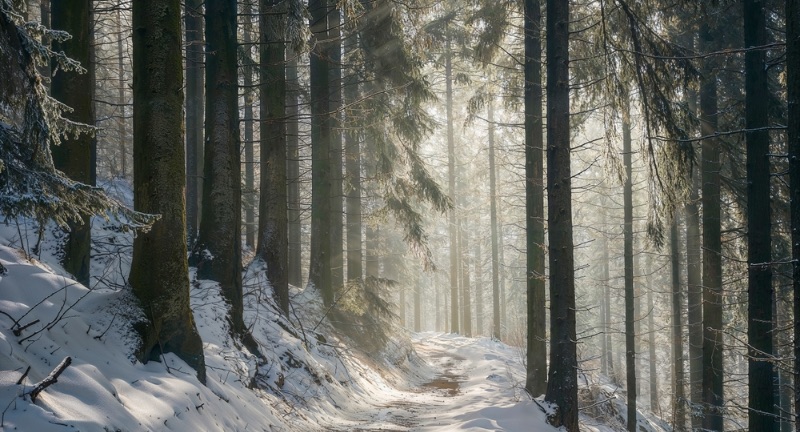
Shutterstock
Snow may look beautiful, but it comes with a lot of difficulties that are just plain annoying. From tricky driving conditions to the tiresome task of shoveling your driveway, there are many reasons to dislike snow. The cold temperatures mixed with increased risk make everyday tasks a bother. While many people may love snow and travel specifically to see it, here are some reasons to get as far as possible from snow.
Slippery roads

Shutterstock
Snow and ice can create hazardous conditions on roads, making them slippery and difficult to navigate. Driving on slick roads increases the risk of accidents, even for experienced drivers. Sudden stops or sharp turns become much more dangerous. It’s a constant worry that snow and ice will cause a crash or delay.
Shoveling driveways

Shutterstock
Shoveling snow is physically demanding and time-consuming. It’s a chore that must be done regularly during snowy weather to keep pathways clear. The cold and wetness make it an unpleasant task, and overexertion can lead to injury. After a heavy snowfall, it can feel like an endless task to clear it all.
Freezing temperatures

Shutterstock
Snow typically comes with bitterly cold temperatures, making it uncomfortable to be outside. Exposure to extreme cold can lead to frostbite or hypothermia if precautions aren’t taken. The cold can also cause health issues like stiff joints or breathing problems. It’s difficult to enjoy outdoor activities when temperatures dip too low.
Wet clothing

Shutterstock
Snow can quickly melt into water, soaking your clothes when you’re outside. Wet socks, shoes, and gloves lead to discomfort and cold skin. It can take hours for wet clothing to dry properly, especially when it’s freezing outside. Having to deal with cold, wet clothes after being outside is one of the worst aspects of snow.
Salt stains on shoes

Shutterstock
Road salt used to melt snow often leaves unsightly stains on shoes and boots. These stains can be tough to remove and can ruin the appearance of your footwear. The buildup of salt can also damage leather or fabric over time. Constantly cleaning your shoes becomes a nuisance during the snowy season.
Reduced visibility while driving

Shutterstock
Snow reduces visibility on the road, especially during a snowstorm. Blizzards or heavy snowfall can make it nearly impossible to see more than a few feet in front of you. Drivers may struggle to spot hazards, pedestrians, or other vehicles. This makes driving in snowstorms stressful and dangerous.
Increased heating bills

Shutterstock
Cold weather means that heating systems have to work harder, driving up utility bills. As snow falls, the cold air seeps into homes, making it harder to stay warm. Keeping your home at a comfortable temperature during the winter can become an expensive burden. The higher cost of heating during snow season can add up quickly.
Snowplows causing traffic delays

Shutterstock
While snowplows are essential for clearing roads, they often cause significant traffic delays. Snowplows can block lanes or drive at slow speeds while working, which can create congestion. The need to wait for roads to be cleared can make travel time unpredictable. It’s frustrating to get stuck behind a plow when you’re trying to get somewhere quickly.
Snowbanks blocking sidewalks

Shutterstock
Snowbanks that form on the side of the road can block sidewalks, making it difficult for pedestrians to get through. This creates a safety hazard, especially for those with mobility issues. People often have to walk in the street to avoid these snowbanks, risking their safety. In some cases, the snow piles are left untouched, creating an ongoing obstacle until the next thaw.
Messy floors

Shutterstock
Snow often results in wet, muddy footprints being tracked indoors. This leaves floors looking dirty and requires constant cleaning. The wetness from snow can cause damage to carpets or wood floors if not dealt with quickly. It can feel like a never-ending cleaning job to maintain your floors during snow season.
Shorter daylight hours

Shutterstock
During the winter, the days are shorter, and daylight fades quickly. This means that it gets dark earlier, limiting the time available to enjoy outdoor activities. Less sunlight can also affect mood and energy levels. The lack of daylight can make winter feel even longer and more difficult to endure.
Frostbite risk

Shutterstock
The cold temperatures associated with snow increase the risk of frostbite, particularly on exposed skin. Prolonged exposure to the cold can lead to numbness, pain, and even permanent damage to tissue. Frostbite is especially dangerous for children and the elderly. It’s important to take precautions, like bundling up, to avoid frostbite during snowy conditions.
Difficulty parking

Shutterstock
Snow can make parking difficult, as spaces may be covered or reduced in size due to snow accumulation. Streets may also be narrowed by snowbanks, leaving limited room for parking. The added challenge of finding parking during a snowstorm can create frustration. People may have to walk further to get to their destination, especially when parking spots are scarce.
Ice under the snow

Shutterstock
Ice that forms beneath a layer of snow is a hidden hazard, often undetectable to the eye. Walking or driving over ice can lead to slips, falls, or accidents. In some cases, the ice may be so thick that it’s impossible to remove. This increases the risk of injury and makes snow removal efforts more difficult.
Snow accumulation on roofs

Shutterstock
Heavy snow accumulation on rooftops can pose structural risks to buildings. The weight of the snow can cause roofs to collapse, especially on older or poorly maintained buildings. Snow on the roof can also lead to leaks when it melts and enters through cracks. Regular roof inspections become necessary during heavy snowfall.
Wet dog fur

Shutterstock
When it snows, dogs bring in snow and wet fur from outside, making a mess indoors. Their paws may also track snow and ice, which can melt into puddles on your floors. Dogs can be cold and uncomfortable if they get too wet, requiring extra care and drying off. Managing a wet dog after snowy outdoor adventures can be a hassle.
Snow tires are expensive

Shutterstock
Snow tires are a costly investment, and not everyone can afford them. These tires are necessary for better traction on snow-covered roads, but the price can be prohibitive. Many people have to switch out their regular tires for snow tires when the weather turns cold, adding another expense. For those on a budget, the cost of snow tires can add financial strain during the winter months.
Longer commutes

Shutterstock
Snow leads to longer commute times, as travel speeds slow down due to road conditions. Drivers may need to take extra caution, driving more slowly in snowy conditions. Traffic jams can become more common as roads get slick, and delays can pile up. Getting stuck in traffic during snowy weather can be stressful and frustrating.
Snowstorms causing power outages

Shutterstock
Snowstorms can knock down power lines, leading to widespread power outages. These outages can last for hours or even days, causing inconvenience and discomfort. Without electricity, heating systems fail, and people are left without heat or light. Power outages during snowstorms can create serious safety concerns, especially in freezing temperatures.
The cold air makes breathing uncomfortable

Shutterstock
The cold air associated with snow can make it difficult to breathe, especially for people with respiratory issues. Cold air can irritate the lungs and exacerbate conditions like asthma or bronchitis. Breathing in chilly, dry air can make outdoor activities less enjoyable or even dangerous for some. Even a short period outside can leave you gasping for breath.
Dangerous black ice

Shutterstock
Black ice forms when a thin layer of ice is spread over dark asphalt, making it invisible to the naked eye. It’s incredibly dangerous because it can’t be seen until it’s too late. Drivers and pedestrians are often caught off guard by black ice, which can lead to falls, crashes, and injuries. Even experienced drivers can struggle to detect and react to black ice in time.
Limited outdoor activities

Shutterstock
Snow limits outdoor activities, as it makes some areas unsafe to walk or play in. It can be challenging to exercise or run outdoors when there’s snow and ice on the ground. Sports like hiking or biking become difficult or dangerous during snowy weather. For those who enjoy outdoor recreation, snow can feel like an unwelcome barrier.
Snow removal equipment malfunctions

Shutterstock
Snow removal equipment, such as snow blowers, often malfunctions during use, leading to frustration. Mechanical breakdowns can leave areas unplowed or snowed in until repairs are made. The need for constant maintenance during the winter months can be both time-consuming and costly. Without functioning snow removal equipment, clearing paths becomes even more difficult.
Muddy patches after snow melts

Shutterstock
When snow melts, it leaves behind slushy, muddy patches that can make areas look unkempt. These messy puddles of snowmelt are difficult to clean and often ruin the appearance of yards or walkways. The transition from snow to spring is often messy and unpleasant to deal with. It can take days or weeks for the ground to fully dry out after the snow has melted.
Accumulation on car windows

Shutterstock
Snow often accumulates on car windows, creating visibility issues when driving. This requires drivers to spend extra time clearing snow from windshields and mirrors before starting a trip. In some cases, ice may form on windows, making it even more difficult to clear. Neglecting to remove snow from car windows can lead to unsafe driving conditions.
Decreased mobility

Shutterstock
Snow can make it difficult to move around, especially in areas with heavy accumulation. Walking through deep snow or on icy patches can be exhausting and dangerous. People with mobility issues, like the elderly or disabled, may find it impossible to get around. Snow and ice force people to stay indoors, limiting their freedom of movement.
Conclusion

Shutterstock
While snow can create a beautiful scene, its difficulties are undeniable. The cold, slippery conditions and the time-consuming tasks that it causes make winter the worst. Despite the winter wonderland, it is easy to see why so many people have a love-hate relationship with snow. Whether you’re dealing with wet shoes or driveways, the problems with snow should make you want to be a snowbird.

 Celebrity News3 days ago
Celebrity News3 days ago
 Lifestyle4 months ago
Lifestyle4 months ago
 Celebrity News3 weeks ago
Celebrity News3 weeks ago
 Entertainment2 days ago
Entertainment2 days ago
 Entertainment3 weeks ago
Entertainment3 weeks ago
 Entertainment3 weeks ago
Entertainment3 weeks ago
 Entertainment3 weeks ago
Entertainment3 weeks ago
 Entertainment3 weeks ago
Entertainment3 weeks ago







































